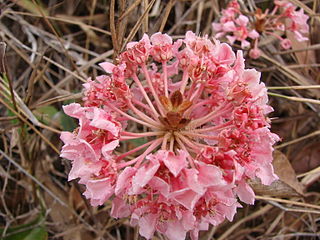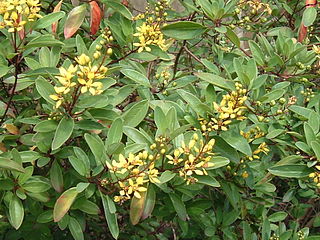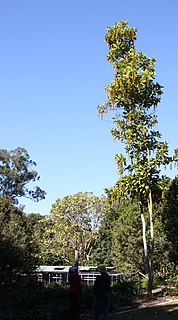
Mezia is a genus in the Malpighiaceae, a family of about 75 genera of flowering plants in the order Malpighiales. Mezia comprises 10 species of woody vines and lianas native to South America, with one species extending into Panama.
Carolus is a genus in the Malpighiaceae, a family of about 75 genera of flowering plants in the order Malpighiales. Carolus comprises six species of woody vines native to Mexico, Central America, the Lesser Antilles, and South America.
Adelphia is a genus in the Malpighiaceae, a family of about 75 genera of flowering plants in the order Malpighiales. Adelphia comprises four species of woody vines native to the West Indies, Mesoamerica, and western South America.
Alicia is a genus in the Malpighiaceae, a family of about 75 genera of flowering plants in the order Malpighiales. Alicia comprises 2 species of woody vines widespread in South America.

Pterandra is a genus in the Malpighiaceae, a family of about 75 genera of flowering plants in the order Malpighiales. Pterandra comprises 15 species of trees, shrubs, and subshrubs, all but two native to South America, principally Colombia, Venezuela, and Brazil; the exceptions are from Panama. There are only some ornamental plants introduced in China, and there are no native varieties.
Amorimia is a genus in the Malpighiaceae, a family of about 75 genera of flowering plants in the order Malpighiales. Amorimia comprises ten species of woody vines native to South America.
Malpighiodes is a genus in the Malpighiaceae, a family of about 75 genera of flowering plants in the order Malpighiales. Malpighiodes comprises 4 species of woody vines native to northern South America.

Galphimia is a genus in the Malpighiaceae, a family of about 75 genera of flowering plants in the order Malpighiales; the name is an anagram of Malpighia.Galphimia comprises 26 species of large herbs, shrubs, and treelets. Twenty-two species occur in Mexico, one extending into Texas and one ranging to Nicaragua; four species occur in South America, south of the Amazon Basin. Galphimia gracilis is widely cultivated in warm regions throughout the world. Eight species are distinctive in that the petals become stiff and papery, and persist past the stage of fruit maturation.

Mascagnia is a genus in the Malpighiaceae, a family of about 75 genera of flowering plants in the order Malpighiales. The genus Mascagnia comprises about 45 species that occur in diverse habitats from northern Mexico and the Caribbean to northern Argentina and south-eastern Brazil.
Spachea is a genus in the Malpighiaceae, a family of about 75 genera of flowering plants in the order Malpighiales. Spachea comprises 6 species of shrubs and trees growing in wet forests. One species occurs in Cuba, 2 species in southern Central America with one of those also in adjacent Colombia, and 3 species in northern South America. Spachea correae, native to Costa Rica and Panama, is listed in the IUCN Red List of Threatened Species.

Lophanthera is a genus in the Malpighiaceae, a family of about 75 genera of flowering plants in the order Malpighiales. Lophanthera comprises 5 species of shrubs and trees, all but one native to the Amazonian South America; the exception is from Costa Rica. Lophanthera lactescens has become popular in recent decades as a cultivated ornamental in many warm regions of the Old and New World. It is propagated by cuttings and seeds.

Galphimia gracilis, a species in the genus Galphimia of the family Malpighiaceae, is native to eastern Mexico. It is widely cultivated in warm regions throughout the world, often under the common names gold shower or shower-of-gold, slender goldshower or sometimes thryallis. In horticultural publications, in the nursery trade, and on websites, this species is commonly but mistakenly referred to as Galphimia glauca, Galphimia brasiliensis, Thryallis glauca, Thryallis gracilis, or often in South America, Thryallis brasiliensis.
Lophopterys is a genus in the Malpighiaceae. Lophopterys comprises seven species of woody vines and shrubs of diverse habitats in South America south to about 23°.

Callaeum is a genus in the Malpighiaceae, a family of about 75 genera of flowering plants in the order Malpighiales. Callaeum comprises 11 species of woody vines and shrubs occurring from western Texas to Mexico, Central America, and South America. Two species, C. macropterum and C. septentrionale are cultivated as ornamentals in Arizona and California.
Christianella is a genus in the Malpighiaceae, a family of about 75 genera of flowering plants in the order Malpighiales. Christianella comprises 5 species of woody vines and shrubby habit occurring in forests, roadside thickets, and shrubby savannas in southeastern Mexico, Central America, and South America.
Jubelina is a genus in the Malpighiaceae, a family of about 75 genera of flowering plants in the order Malpighiales. Jubelina comprises 6 species of woody vines occurring in tropical wet primary and secondary forests of Central America and South America.
Bronwenia is a genus in the Malpighiaceae, a family of about 75 genera of flowering plants in the order Malpighiales. Bronwenia comprises 10 species of shrubs and woody vines native to Mexico, Central America, and South America.
Cottsia is a genus in the Malpighiaceae, a family of about 75 genera of flowering plants in the order Malpighiales. Cottsia comprises 3 species of slender twining vines native to northern Mexico and extending into Texas, New Mexico, and Arizona. The species of Cottsia were formerly included in Janusia, a genus of South America.
Dicella is a genus in the Malpighiaceae, a family of about 75 genera of flowering plants in the order Malpighiales. Dicella includes seven species, assigned to two sections. Section Dicella comprises D. bracteosa and D. nucifera, found in southeastern Brazil and adjacent Paraguay and Argentina. Section Macropterys includes D. aciculifera, known only from Costa Rica, and D. conwayi, D. julianii, D. macroptera, and D. oliveirae, all of South America from Colombia south to about 19°S





